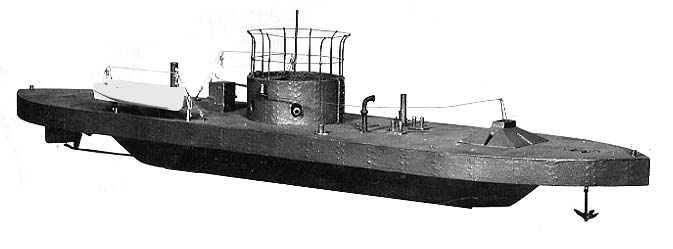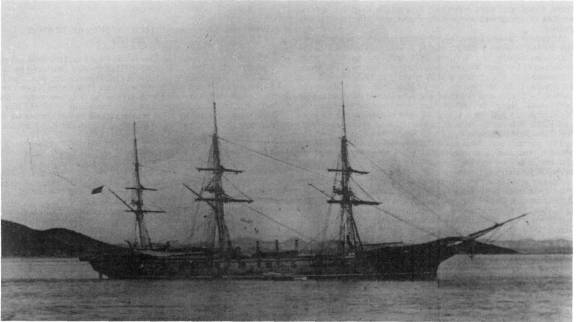|
Lewis A. Kimberly
Rear Admiral Lewis Ashfield Kimberly (April 22, 1830 – January 28, 1902) was an officer in the United States Navy during the American Civil War and the years following. Biography Early life and career Kimberly was born in Troy, New York, and was appointed a midshipman on 8 December 1846. He served aboard the sloop in the Africa Squadron in 1847–50, then in the Pacific aboard the frigate during 1850–52, receiving promotion to passed midshipman on June 8, 1852. He then returned to African waters, serving in the sloops and in 1853–56, and was promoted to master and lieutenant on September 15 and 16, 1855. Kimberly spent some time stationed at the Boston Navy Yard, and then served aboard the sloop in the East India Squadron between July 1857 and April 1860, before joining the newly commissioned steam sloop which sailed for the Mediterranean in October 1860, finally returning to the United States in July 1861 after the outbreak of the Civil War. Between 1856 and ... [...More Info...] [...Related Items...] OR: [Wikipedia] [Google] [Baidu] |
Troy, New York
Troy is a city in the U.S. state of New York and the county seat of Rensselaer County. The city is located on the western edge of Rensselaer County and on the eastern bank of the Hudson River. Troy has close ties to the nearby cities of Albany and Schenectady, forming a region popularly called the Capital District. The city is one of the three major centers for the Albany metropolitan statistical area, which has a population of 1,170,483. At the 2020 census, the population of Troy was 51,401. Troy's motto is ''Ilium fuit, Troja est'', which means "Ilium was, Troy is". Today, Troy is home to Rensselaer Polytechnic Institute, the oldest private engineering and technical university in the US, founded in 1824. It is also home to Emma Willard School, an all-girls high school started by Emma Willard, a women's education activist, who sought to create a school for girls equal to their male counterparts. Due to the confluence of major waterways and a geography that supported water power ... [...More Info...] [...Related Items...] OR: [Wikipedia] [Google] [Baidu] |
West Gulf Blockading Squadron
The Union blockade in the American Civil War was a naval strategy by the United States to prevent the Confederate States of America, Confederacy from trading. The blockade was proclaimed by President Abraham Lincoln in April 1861, and required the monitoring of of Atlantic Ocean, Atlantic and Gulf of Mexico, Gulf coastline, including 12 major ports, notably New Orleans and Mobile, Alabama, Mobile. Those Blockade runners of the American Civil War, blockade runners fast enough to evade the Union Navy could carry only a small fraction of the supplies needed. They were operated largely by foreign citizens, making use of neutral ports such as Havana, Cuba, Havana, Nassau, Bahamas, Nassau and Bermuda. The Union commissioned around 500 ships, which destroyed or captured about 1,500 blockade runners over the course of the war. Proclamation of blockade and legal implications On April 19, 1861, President Lincoln issued a ''Proclamation of Blockade Against Southern Ports'': Whereas an in ... [...More Info...] [...Related Items...] OR: [Wikipedia] [Google] [Baidu] |
East Coast Of The United States
The East Coast of the United States, also known as the Eastern Seaboard, the Atlantic Coast, and the Atlantic Seaboard, is the coastline along which the Eastern United States meets the North Atlantic Ocean. The eastern seaboard contains the coastal states and areas east of the Appalachian Mountains that have shoreline on the Atlantic Ocean, namely, Maine, New Hampshire, Massachusetts, Rhode Island, Connecticut, New York, New Jersey, Delaware, Maryland, Virginia, North Carolina, South Carolina, Georgia, and Florida.General Reference Map , , 2003. Toponymy and composition T ...[...More Info...] [...Related Items...] OR: [Wikipedia] [Google] [Baidu] |
Monitor (warship)
A monitor is a relatively small warship which is neither fast nor strongly armored but carries disproportionately large guns. They were used by some navies from the 1860s, during the First World War and with limited use in the Second World War. The original monitor was designed in 1861 by John Ericsson, who named it . They were designed for shallow waters and served as coastal ships. The term also encompassed more flexible breastwork monitors, and was sometimes used as a generic term for any turreted ship. In the early 20th century, the term was revived for shallow-draught armoured shore bombardment vessels, particularly those of the Royal Navy: the s carried guns firing heavier shells than any other warship ever has, seeing action (albeit briefly) against German targets during World War I. The ''Lord Clive'' vessels were scrapped in the 1920s. The term "monitor" also encompasses the strongest of riverine warcraft, known as river monitors. During the Vietnam War these much sm ... [...More Info...] [...Related Items...] OR: [Wikipedia] [Google] [Baidu] |
Asiatic Station
The Asiatic Squadron was a squadron of United States Navy warships stationed in East Asia during the latter half of the 19th century. It was created in 1868 when the East India Squadron was disbanded. Vessels of the squadron were primarily involved in matters relating to American commerce with China and Japan, though it participated in several conflicts over 34 years of service until becoming the Asiatic Fleet in 1902. History Korean Expedition In May 1871, Rear Admiral John Rodgers went to Korea, commanding an expedition of five Asiatic Squadron vessels, the screw frigate , the screw sloops-of-war and , the sidewheel gunboat , and the screw tug . The objective of the operation was to ascertain the fate of the merchant ship SS ''General Sherman'', establish trade relations, and receive an assurance from the Joseon government that shipwrecked American sailors would be safely treated should they become stranded in Korea. On 1 June 1871, while Rear Admiral Rodgers was negot ... [...More Info...] [...Related Items...] OR: [Wikipedia] [Google] [Baidu] |
Screw Sloop
A screw sloop is a propeller-driven sloop-of-war. In the 19th century, during the introduction of the steam engine, ships driven by propellers were differentiated from those driven by paddle-wheels by referring to the ship's ''screws'' (propellers). Other propeller-driven warships included screw frigates and screw corvette A corvette is a small warship. It is traditionally the smallest class of vessel considered to be a proper (or " rated") warship. The warship class above the corvette is that of the frigate, while the class below was historically that of the slo ...s. See also * CSS ''Alabama'' * USS ''Alaska'' * USS ''Contoocook'' * HMS ''Gannet'', now a museum ship. * USS ''Housatonic'', sunk by the first successful submarine attack. * USS ''Wyoming'' * * Ship types {{navy-stub ... [...More Info...] [...Related Items...] OR: [Wikipedia] [Google] [Baidu] |
Receiving Ship
A hulk is a ship that is afloat, but incapable of going to sea. Hulk may be used to describe a ship that has been launched but not completed, an abandoned wreck or shell, or to refer to an old ship that has had its rigging or internal equipment removed, retaining only its buoyant qualities. The word hulk also may be used as a verb: a ship is "hulked" to convert it to a hulk. The verb was also applied to crews of Royal Navy ships in dock, who were sent to the receiving ship for accommodation, or "hulked". Hulks have a variety of uses such as housing, prisons, salvage pontoons, gambling sites, naval training, or cargo storage. In the days of sail, many hulls served longer as hulks than they did as functional ships. Wooden ships were often hulked when the hull structure became too old and weak to withstand the stresses of sailing. More recently, ships have been hulked when they become obsolete or when they become uneconomical to operate. Sheer hulk A sheer hulk (or shear hulk) w ... [...More Info...] [...Related Items...] OR: [Wikipedia] [Google] [Baidu] |
European Squadron
The European Squadron, also known as the European Station, was a part of the United States Navy in the late 19th century and the early 1900s. The squadron was originally named the Mediterranean Squadron and renamed following the American Civil War. In 1905, the squadron was absorbed into the North Atlantic Fleet. Second Anglo-Egyptian War The Egyptian Expedition in June and July 1882 was a response by the United States to the British and French attack on Alexandria during the Anglo-Egyptian War. To protect American citizens and their property within the city, ships of the European Squadron, under Rear Admiral James Nicholson, were sent to Egypt with orders to observe the conflict ashore and make a landing if necessary. British and French forces heavily damaged the city and started a large fire so a force of marines and sailors were landed and they assisted in fire fighting and guarding the American consulate from insurgents. Casper F. Goodrich, who served as an executive off ... [...More Info...] [...Related Items...] OR: [Wikipedia] [Google] [Baidu] |
Military Order Of The Loyal Legion Of The United States
The Military Order of the Loyal Legion of the United States (MOLLUS), or simply the Loyal Legion is a United States patriotic order, organized April 15, 1865, by three veteran officers of the Army. The original membership was composed of members of the Army, Navy, or Marine Corps of the United States, who had served during the American Civil War as commissioned officers in Federal service, or who had served and thereafter been commissioned, and who thereby "had aided in maintaining the honor, integrity, and supremacy of the national movement" during the Civil War. The Loyal Legion was formed by in response to rumors from Washington of a conspiracy to destroy the Federal government by assassination of its leaders, in the immediate aftermath of the assassination of President Abraham Lincoln. The founding members stated their purpose as the cherishing of the memories and associations of the war waged in defense of the unity and indivisibility of the Republic; the strengthening of th ... [...More Info...] [...Related Items...] OR: [Wikipedia] [Google] [Baidu] |
Battle Of Mobile Bay
The Battle of Mobile Bay of August 5, 1864, was a naval and land engagement of the American Civil War in which a Union fleet commanded by Rear Admiral David G. Farragut, assisted by a contingent of soldiers, attacked a smaller Confederate fleet led by Admiral Franklin Buchanan and three forts that guarded the entrance to Mobile Bay: Morgan, Gaines and Powell. Farragut's order of "Damn the torpedoes! Four bells. Captain Drayton, go ahead! Jouett, full speed!" became famous in paraphrase, as "Damn the torpedoes, full speed ahead!" The battle was marked by Farragut's seemingly-rash but successful run through a minefield that had just claimed one of his ironclad monitors, enabling his fleet to get beyond the range of the shore-based guns. This was followed by a reduction of the Confederate fleet to a single vessel, ironclad CSS ''Tennessee''. ''Tennessee'' did not then retire, but engaged the entire Northern fleet. ''Tennessee''s armor enabled her to inflict more injury than s ... [...More Info...] [...Related Items...] OR: [Wikipedia] [Google] [Baidu] |
Executive Officer
An executive officer is a person who is principally responsible for leading all or part of an organization, although the exact nature of the role varies depending on the organization. In many militaries and police forces, an executive officer, or "XO", is the second-in-command, reporting to the commanding officer. The XO is typically responsible for the management of day-to-day activities, freeing the commander to concentrate on strategy and planning the unit's next move. Administrative law While there is no clear line between principal executive officers and inferior executive officers, principal officers are high-level officials in the executive branch of U.S. government such as department heads of independent agencies. In ''Humphrey's Executor v. United States'', 295 U.S. 602 (1935), the Court distinguished between executive officers and quasi-legislative or quasi-judicial officers by stating that the former serve at the pleasure of the president and may be removed at their di ... [...More Info...] [...Related Items...] OR: [Wikipedia] [Google] [Baidu] |
Vicksburg, Mississippi
Vicksburg is a historic city in Warren County, Mississippi, United States. It is the county seat, and the population at the 2010 census was 23,856. Located on a high bluff on the east bank of the Mississippi River across from Louisiana, Vicksburg was built by French colonists in 1719, and the outpost withstood an attack from the native Natchez people. It was incorporated as Vicksburg in 1825 after Methodist missionary Newitt Vick. During the American Civil War, it was a key Confederate river-port, and its July 1863 surrender to Ulysses S. Grant, along with the concurrent Battle of Gettysburg, marked the turning-point of the war. The city is home to three large installations of the United States Army Corps of Engineers, which has often been involved in local flood control. Status Vicksburg is the only city in, and the county seat of, Warren County, Mississippi, United States. It is located northwest of New Orleans at the confluence of the Mississippi and Yazoo rivers, and ... [...More Info...] [...Related Items...] OR: [Wikipedia] [Google] [Baidu] |








.jpg)

